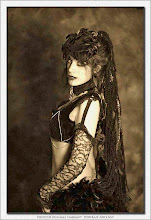I've been involved in many a discussion about what makes Bellydance "Theatrical".
Let me put forth the Wikipedia definition of theatre, and go from there:
"Theatre (in American English usually theater[1]) is a collaborative form of fine art that uses live performers to present the experience of a real or imagined event before a live audience in a specific place. The performers may communicate this experience to the audience through combinations of gesture, speech, song, music or dance. Elements of design and stagecraft are used to enhance the physicality, presence and immediacy of the experience."
There has been a trend in Bellydance in which many dancers call themselves "Theatrical" Bellydancers. I am very glad for this! But, I do have one condition for my gladness: that the performances that self-described Bellydancers do are indeed "theatrical".
| Photo by Alison Perkel |
By the definition above, one with which I mostly agree, theatricality involves the creation of an experience for the audience and the performer. And I would say that it involves communication, the creation of an "event" through which the participants can be transported to another place and time. Or, conversely, or even simultaneously, become more aware of, and deeply involved in, the present.
To me a truly successful Theatrical performance makes the audience (even other bellydancers!) forget about the technical aspects of a piece; that they become wholly engrossed in the performance, in the story and the emotional experience.
I recently had a discussion with a lovely student of mine about what constitutes "theatricality". She had mentioned how much she enjoyed Theatrical Bellydancer Anasma's performances, in that they have a story with a beginning and ending, and that her work is inspiring in that way. (I, too love Anasma's work.)
.jpg) |
| Ruth St Denis |
There is also cabaret style theatricality, which does not necessarily have a ritual or narrative element, but embodies a character on the stage none-the-less. Through watching the Theatrical cabaret performer we are brought into her world, maybe made to laugh, or cry, or become conscious of our own sexuality or foolishness or grace, or inspired to dance ourselves.
I sometimes see performers calling themselves "theatrcial" when they are not. Let me make a few fast friends here: it is not enough to write a great performance intro to be read by the MC stating that one is the goddess such and such doing a shamanistic ritual theatrical piece about the myth of such and such and then get on stage and do the same Tribal schtick that one always does. No. that is not theatrical. Nor is it Theatrical to get dressed up in an elaborate costume and say one is (Fill in the Blank) and then do a bunch of super-duper moves without meaning. Costuming is important but it is only part of the art form.
No. Theatre is an fine art form in itself. It has technique, theory, history, etc. Many dancers (particularly, eh-hem, Tribal Fusion dancers) will complain that Theatrical dancers are not demonstrating enough "technique" in their performances; that they are "resorting" to "tricks" instead of really "dancing". Oh bullshit. (Though maybe this is true sometimes with an unskilled actress) Again, Theatre itself has a technique, a technique that takes years to learn. And, when done well, it can make the difference between dance that is truly art, as opposed to dance that is a series of skillful moves, which is craft.
A successful Theatrical piece has both excellent dance form and technique as well as dramatic skill and technique. It also requires an extra element of heart and soul in order to create the magic needed to bring the audience into the experience of the piece.
To do good Theatrical Bellydance: keep going to Bellydance classes. Study form. Do your drills. But also, study Theatre. Take a class. Try improv. And maybe most important of all: study yourself. Study your psychology. Learn what moves you. Define what you want to express. Take the chance at being emotionally authentic. Be vulnerable. Be bold.
Aepril will be teaching her workshop "A Look Beyond: The Art of Costuming and Male-up for Theatrical Bellydance" on Friday at 6pm at Lumen Obscura in Santa Cruz, CA.












